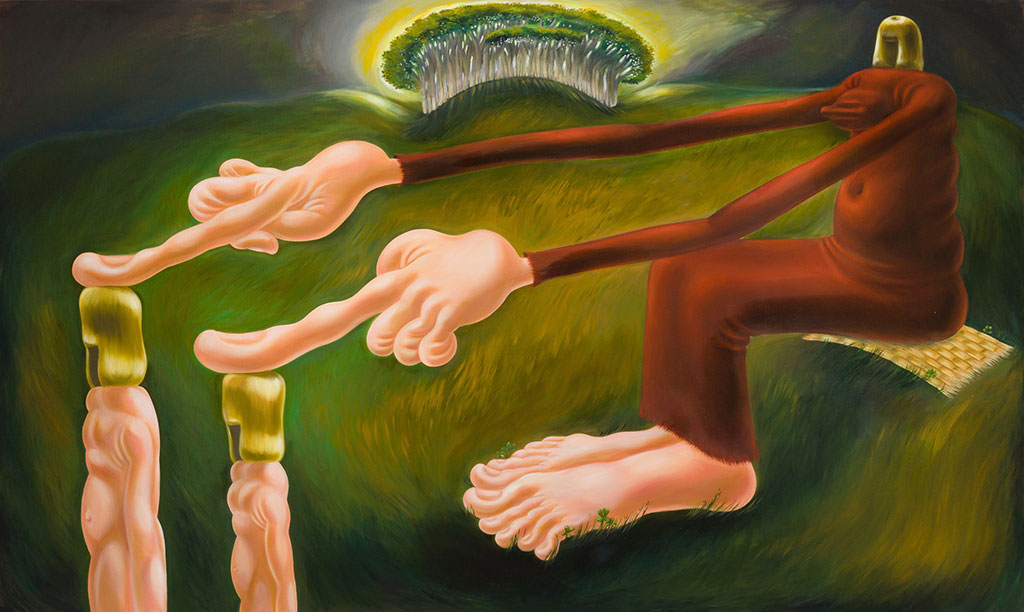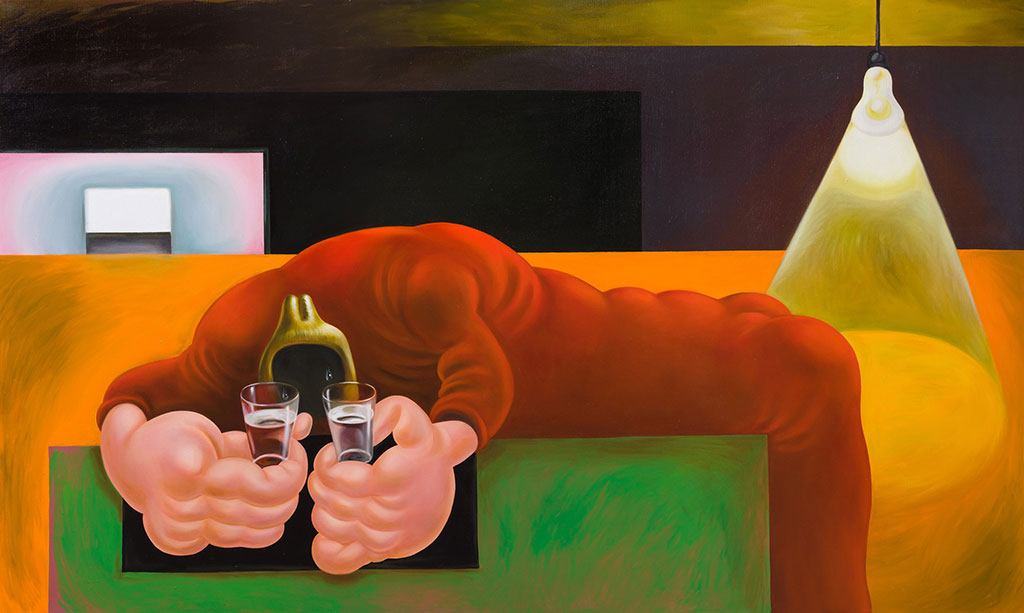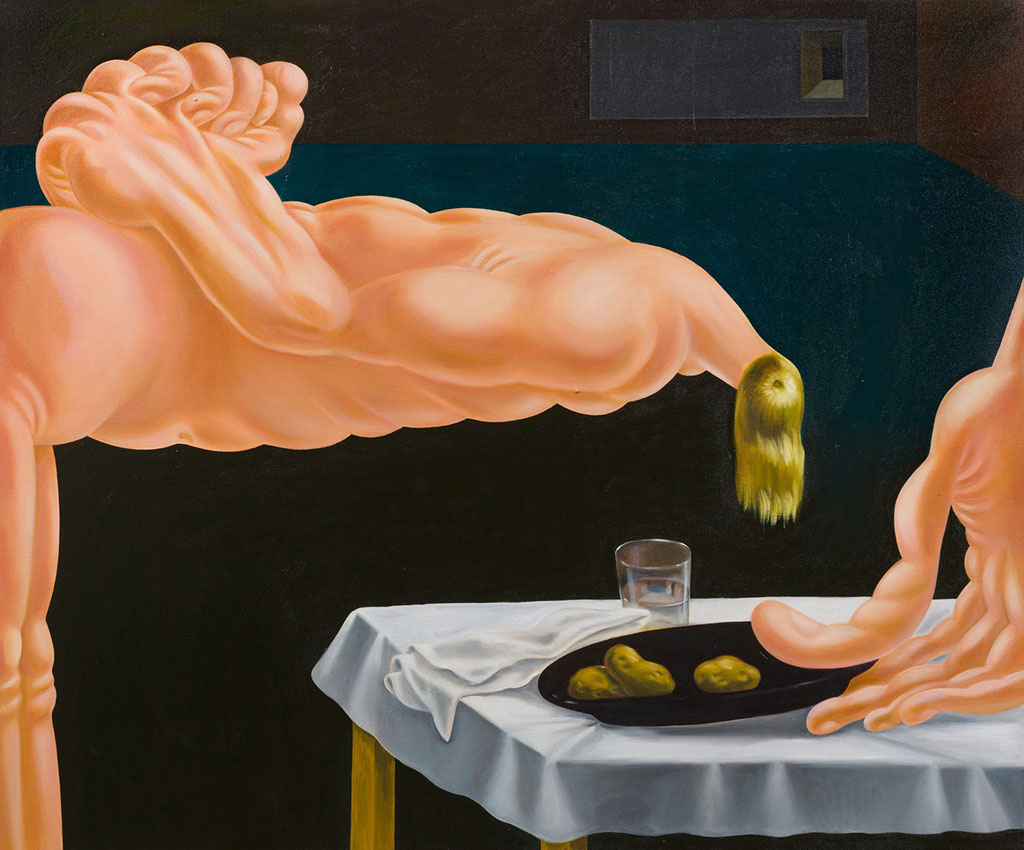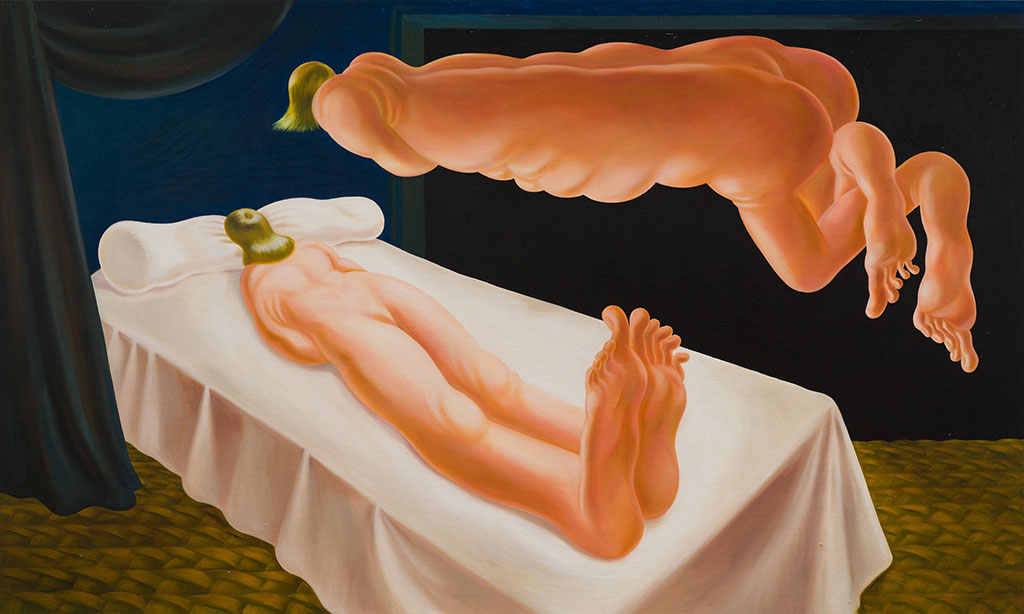ART CITIES:N.York-Louise Bonnet
 Known for her portraits of exaggerated proportions and grotesque features, Louise Bonnet continually explores emotions of melancholy, loneliness, nostalgia and grief in her works. Her strong sense of corporeality and precise observation of the tension and movements of body parts result in bending extremities, bloated noses, swollen hands and feet. Bonnet’s protagonists, often situated in everyday environments and domestic interiors, appear involuntarily stretched. Their bodies seem to reflect a disturbing discomfort, an uneasy state of mind that makes their limbs writhe.
Known for her portraits of exaggerated proportions and grotesque features, Louise Bonnet continually explores emotions of melancholy, loneliness, nostalgia and grief in her works. Her strong sense of corporeality and precise observation of the tension and movements of body parts result in bending extremities, bloated noses, swollen hands and feet. Bonnet’s protagonists, often situated in everyday environments and domestic interiors, appear involuntarily stretched. Their bodies seem to reflect a disturbing discomfort, an uneasy state of mind that makes their limbs writhe.
By Dimitris Lempesis
Photo: Gagosian Gallery Archive
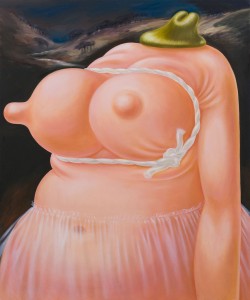
The paintings of Louise Bonnet’s exhibition “The Hours” were inspired by medieval illuminated manuscripts such as the “Très Riches Heures du Duc de Berry” (c. 1412–16), the books of hours that functioned as time planners through the depiction of daily prayers and seasonal activities. However, rather than honest labors, Bonnet’s Hours foregrounds a series of impossibly distorted, ambiguously gendered figures engaged in nightmarish variations on mundane routines, such as eating and sleeping. Reflecting the nature of human experience during the crisis of the current pandemic, Bonnet’s figures, with their bloated extremities and faces devoid of features, are uncanny embodiments of emotional tension. As its title and inspiration suggest, “The Hours” also mines the rich history of Christian imagery in European painting. “Calvary with Potato” (2020), for example, depicts blood gushing from a wounded finger, a synecdochical allusion to Jesus on the cross and to the experience of psychological pain. But while the injured figure writhes in agony, the minute size of its wound hardly seems to justify such a performance. Bonnet’s figure, with its extended neck, also recalls the tormented subjects of Francis Bacon’s “Three Studies for Figures at the Base of a Crucifixion” (1944). In “Dawn” and “Vespers” (both 2020), meanwhile, she sets pneumatic female torsos against imaginary landscapes, recalling Renaissance characterizations of the Madonna. The exhibition emphasizes the sexual perversity of the figures: the enormous breasts of the subject of “Vespers” (2020) are bound by a length of rope, while in “Visitation” (2020), the spectral double of a supine figure hovers overhead, naked and sexless. Treading a fine line between humour and discomfort, comedy and tragedy, the anonymous figures are staged in isolation often against diminished backgrounds, their physicality rendering them statuesque yet faceless. The figures are dramatically lit in settings that border the surreal, from sparse domestic rooms, to moonlit tables. Inspiration for Bonnet’s works derive from such multiple sources as Hitchcock film scenes, Cindy Sherman works, Lucas Cranach paintings, and Renaissance portraits. These references usually appear as distorted as the depicted bodies themselves.
Growing up in Geneva, Switzerland, Louise Bonnet’s tastes always leaned toward the vivid and graphic work of masters such as R. Crumb, Popeye, and Basil Wolverton. Embarking to art school in her hometown, she found herself equally drawn more toward the students of said aesthetic, at the same time, relishing the opportunity to engage in no-holds-barred critical dialogues, a ritual she continues to this day. Upon completion of her studies, Bonnet headed out into the world, ending up in Los Angeles where she began working as a graphic designer, the whole time continuing to make drawings she m/ostly tagged as illustrations until, in 2008, when she was offered a show at LA’s Subliminal Projects. With a deadline hanging over her head, Bonnet found herself for the first time having to, “make paintings”. The works, all done on paper using acrylic paint, were portraits, poppy and flat and already very much showing the telltale signs of the artist’s askew sense of proportion. For Bonnet, the task of putting together an exhibit of paintings was a revelation, prompting an immediate end to her days as a graphic designer, so she could jump with both feet onto her newly limned path. Over the next five years, Bonnet painted and began having studio visits. One visit, with the Australian artist Ricky Swallow, proved particular prescient when Swallow suggested Bonnet try using oil paint. More and more she was finding that acrylic paint was falling shy of where she wanted to go and what she wanted to convey. Moving away from the flat quality of acrylic paint enabled Bonnet to lean deeper into her compositions, both from an aesthetic perspective as well as an emotional, plumbing lurid depths that gave the new canvases a vibrant chiaroscuro. At the same, the introduction of oil paint into her repertoire seemed to trigger yet another resolution within Bonnet. Raised by laid-back hippies, the artist found herself often at loggerheads with the notion that her work somehow always had to exude a kind of loosey goosey quality. That, that was how mellow-minded people created. But it wasn’t working anymore. When it came to her art, Bonnet was much happier when she was making very exacting paintings. And, although she still likes to leave evidence of the hand in the work, Bonner does not want the brushstrokes themselves to mean too much. Or stand alone. Bonnet’s figures often take up almost the entire canvas. After that, there might be a few small but significant touches. The earlier works played more nicely, contained stronger hints of illustrative qualities with nods to the likes of Guston or Saul. More recently, the paintings have begun to take on a much more muscular, minimal quality.
Info: Gagosian Gallery, 821 Park Avenue, New York, Duration: 29/9-7/11/20, Days & Hours: The installation will be viewable exclusively through the storefront windows, 24 hours a day, https://gagosian.com
